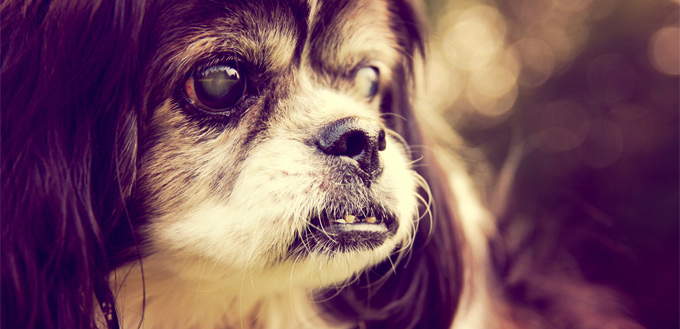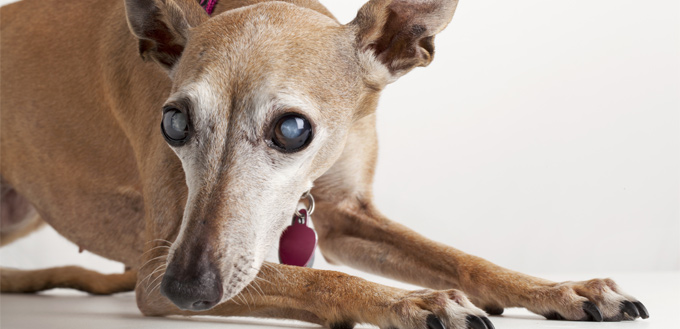As you and your pet dog grow older together, both of you follow a similar fashion throughout the process. Just like you lose your muscle tone, your joints stiffen and your vision might as well not be as good as it used to be. It’s exactly the same in case of your furry friend. In fact, eyesight is a major concern among dogs as they enter their senior years.
You might have heard humans developing cataracts. It’s not at all strange for dogs to develop them. Despite their size, breed, and type, they are susceptible to get diagnosed with cataracts. You must be wondering, what exactly does the term “cataracts” mean and how well can dog parents deal with them?
You need to not to worry! Here’s a guide entailing every detail about cataracts in dogs and how you can possibly treat them.
What are Cataracts?
A cataract damages the eye’s lens, which is what focuses on an object so that your dog can see something. When the transparent lens becomes clouded, differing from complete to partial opacity, it is then called a cataract. Basically, the eye lens (positioned behind the iris) gets clouded as light cannot pass through to the retina. This can lead to vision loss in dogs.
These signs of cloudy eyes that dogs exhibit is actually called nuclear sclerosis, a more refined condition than cataracts. Nuclear sclerosis is likely to affect both the eyes, while cataracts appear only on one eye at a time. Cataracts also appear in both the eyes but usually start in one and then the other. At the initial stages, it doesn’t affect as much as the further stages. Once cataracts reach its last stages, the vision starts to become blurry, hazy and cloudy, which is when you should be really concerned about taking your furry friend to the vet. It’s normal for dogs to get diagnosed with cataracts at the age of 6 or later.
Most of the time, cataracts are inherited from the dog’s biological parents. While all breeds might get caught with cataracts, Siberian Huskies, golden retrievers, miniature schnauzer, Boston terriers, and American cocker spaniel are prone to having it.

Symptoms of Cataracts
Anything that relates to your dog’s vision might be a symptom of cataract. Dogs with less than 30% lens opacity, dogs don’t display any symptoms, whereas the ones with more than 60% opacity of the lens may lose their vision or have problems viewing in dimly lit areas.
As mentioned above, cataracts are inherited. But if you keep a closer eye on your pup, you’ll notice there are other conditions that resemble cataracts too. However, it’s always best to get it examined by your veterinarian to determine the real reason of your pet dog’s eyesight conditions. Here are several different signs we’ve listed that experts believe are symptoms of cataracts:
- Whiteness or grey layer in the pupil of the eye
- Repeatedly rubbing and scratching of the eyes
- Frequent squinting
- Experiencing trouble when looking at a distant
- Sudden skittish behavior
- Irritation or redness in and around the eye areas (it could be because of allergies too)
- Discomfort or hesitancy in new surroundings
- Reluctance to climb the stairs
- Not recognizing their friends or other people properly
- Unsure stepping
- Other signs of blindness and vision impairments
How and Why Exactly Do Cataracts Form?
If you’re wondering how cataracts developed in your pet dog’s eyes even after such delicate care they get at your home, well, there are several other reasons for this.
There is an interesting chemistry behind this. According to dog enthusiasts, the normal eye lenses are maintained in a dehydrated condition whereby, it consists of 66% water and 33% protein. A sodium water pump system inside the lens is what balances the water/protein level. When the biomechanical system in the lens gets damaged, the pump system fails and additional water starts to move into the lens. Therefore, the amount of insoluble protein increases, changing the results to the loss of transparency and formation of cataracts.
It can take weeks or even months for cataracts to develop in any breed of dogs. Besides, there are certain reasons as to why cataracts actually develop among dogs. Here’s why:
- Diabetes
The eye lens needs some amount of glucose. If the concentration gets too high, cataracts start developing rapidly and affect both the eyes. Dogs are likely to develop cataracts even if they are taking insulin. About 75% of diabetic dogs develop severe blinding cataracts within the first year of their diabetes. You should certainly see a vet ASAP if your diabetic dog is showing signs of cataracts.
- Trauma
Whether it’s by an accident or a punctured wound, trauma in dogs can affect an injured eye and result in cataract. If your dog’s eye lens ruptures for any reason, the content leaks through the hole and causes a cataract. It’s not necessary that a dog will develop a cataract immediately after an injury to their eye, but do take note until it’s too late for you to be able to save their eye. For complete safety, make sure that you pay attention to their eye health when taking them for a general health check-up at the vet.
- Congenital
Some dogs are born with cataracts. It doesn’t mean that the cause of it is heredity, they are just born with it. There might have been an issue in the development of their eye lens or their blood vessels that surround the eye lens as it grows during pregnancy. Don’t be surprised if your dog is about 7-months old and already possessing cataract.
- Other Diseases
It could possibly be because of any other disease that they had developed throughout their lifetime. An eye lens can also get “sick” due to any other ocular disease or perhaps a drug reaction. Other examples of poisonous cataracts involve retinal degeneration, specifically progressive retinal atrophy (PRA), glaucoma or uveitis.
- Old Age
This is the typical type of cataract associated with a dog. As they age, they are likely to get caught with these eye diseases and it’s completely normal. This is a slowly progressing disease that develops over time, still requiring proper treatment.

Diagnosis
There’s no need to worry so much about cataracts as it is completely curable. In fact, it is quite easy to treat, although, at present, the only way to cure cataracts is through surgery. In case of a surgery, the original lens of the dog is replaced with an artificial lens and set down into the lens capsule.
In a few rare cases, the vet might diagnose that it’s not possible to insert a replacement for the lens. That’s because the damaged lens will still come out. Even though the dog might improve his/her vision, the blurriness would still persist. Before the surgery, the vet ophthalmologist will need to verify if the dog’s eyes are in healthy condition for the operation.
Here’s a more detailed explanation of the pre-operative evaluations: a cataract is basically a physical barrier to light that your pet dog gets a glimpse of. It’s similar to blocking the camera lens with a cloth or even your palm. This barrier to the eye can only be removed by a surgery. Contrastingly, the retina plays the role of a film in the camera, while the remaining of the eye is the camera itself. Imagine if the camera (or the retina) is not functioning properly, then displacing the lens cover (the cataract) won’t make it work (improve your dog’s vision). In order for the camera to work well, the film must be fine before dismissing the barrier that is over the lens (for the operation to) be worthwhile.
Other Testing
Your vet will perform a complete physical examination that includes eye tests as well as certain other tests to assess their eyes. In addition to that, a general vet may recommend you to visit a separate veterinary ophthalmologist, who is a specialist in curing eye diseases. Typically, a blood test is required for the underlying cause that includes:
- Tests that evaluate the functional behaviours of kidney, liver and pancreatic diseases along with the sugar levels.
- A complete blood count to exclude infections, inflammation, and anaemia with any other conditions.
- Other specialized tests such as polymerase chain reaction (PCR) and cultures testing to get an idea of the function of the retina.
This will enable the vet to determine your dog’s stage of development and the overall health condition. Based on the test results, the vet will recommend treatments:
- Eye drops that will help to ward off inflammation.
- Surgery to remove a cataract, normally by a vet ophthalmologist, if your pet dog is a healthy and an eligible candidate for surgery.
Could Dogs Still See?
Yes, they can still see with those cataracts affected eyes. Dog cataracts can be categorized into three types:
1. Incipient Cataract
This covers less than 15% of the surface area of the top layer of the eye lens. Most dogs wouldn’t even notice this until it starts to develop rapidly. Dogs don’t even need to undergo a surgery at this stage of cataract.
2. Mature Cataracts
This covers the entire eye lens. Dogs at this stage of cataract only see a change in the lightings around them. This stage requires immediate surgery in order to get rid of cataracts and possibly cause more harm to the eye.
3. Immature Cataracts
In between these two stages of cataracts lies the immature cataract. This can be a consequence of a grey area. You can only notice this if your dog’s eye lens is 75% covered with cataracts. They will start showing symptoms after which you can take them to the vet.
Does Cataract Hurt?
Normally, cataracts itself does not hurt. But a dog developing cataract would experience disorientation and uneasiness if they are faced with it all of a sudden.
Typically, cataracts cause discomfort in the eyes due to the inflammation that accompanies with it. When the eye lens starts developing a cataract, the protein structure changes. The body perceives this as a foreign substance. This is what causes inflammation, which can result in glaucoma. Glaucoma, on the other hand, can be extremely painful.
Experts recommend that if you’re looking to treat immature cataracts in your dog, it’s better to start off by putting him/her on a supervision of anti-inflammatory dog cataract eye drops. However, you might need to use these eye drops throughout your dog’s life, making sure to drip it on their eyes from time to time.
On the other hand, there are no such eye drops invented in the market that would cure cataracts. Some say that an antioxidant eye drop can deduce the progression of immature cataracts and improve the overall eyesight. But do bear it in mind that it won’t dissolve cataract itself.

How Do I Tell if My Dog has Cataracts?
If you notice any whiteness in the pupils of your pet dog, it might be cataracts. It’s easy to spot mature and immature cataracts because of its cloudy nature. But for incipient cataracts, you need to look for other signs and symptoms or probably just visit the vet.
Note if your fellow dog is facing trouble to catch food if he/she is sniffing for treats than seeing the one that is in front of them or if he/she is not able to play “fetch” just as usual. In such cases, it’s obvious that they might even have cataracts. It’s something that develops over time, but if your dog has diabetes, you might see them bumping into objects overnight.
Prevention
As we all know that prevention is better than cure, but in this case, there’s not much you can do to prevent your dog from getting cataracts. Above all, if your dog cataracts are inherited, there’s no alternative to a surgery. Of course, you can supplement them with a high-quality diet that includes antioxidants. For instance, omega-3 fatty acids, specifically those in fish oil promotes eye health. Consult your vet nutritionist to inquire them about which is the best for your dog.
Related Post: Fish Oils For Dogs
Other than that, your vet might also suggest you the anti-inflammatory cataract eye drops if your dog is at their first stage of getting caught with cataracts. Normally, the eye drops procedure ramp up approximately for about 4 – 6 months, after which they will reschedule another appointment to recheck your dog’s eyes.
More ways to prevent your dog from getting diagnosed with cataracts include obstructing harmful UV rays. Make sure that your dog is under a shade or wearing a hat when you take them out on sunny days.
You May Also Like: Dog Hats
Post-surgery
Considering everything, as you know that diabetic dogs are an excellent candidate for cataracts, the overall development of cataracts in dogs depends on their age, breed, and genetics. However, do take care of your dog in such circumstances. The success rate of a cataract operation is high, with 85 – 95% of dog patients regaining their eyesight completely. After a cataract has been taken out and an artificial replacement lens has been inserted, the cataract is not likely to grow back.
After the surgery, the dog will be required to wear an E-collar (Elizabethan collar) to prevent them from rubbing or scratching their eyes. Best is if you can grind their nails so that the sharp object cannot influence them to scratch themselves. Plus, do take note on not engaging them in activities like playing, running or barking after they have undergone the surgery. Ensure that the environment around them is calm and quite at least for the first couple of weeks. If they require an overnight stay at the hospital, go ahead. This will ensure their successful recovery.
You May Also Like: Dog Cones
As the pet parent, you’ll strictly need to follow your vet’s instructions, especially when it comes to the medications such as antibiotics, eye drops, and anti-inflammatory. Medications are often provided for a fruitful recovery as well as to prevent any eye infections from occurring in the future. You’ll need to keep re-visiting the vet several times for the first few weeks and eventually annually. Remember, the cataract surgery in your dog might NOT be successful. Although mostly, the success rate is comparatively high, there are unfortunate cases too. Therefore, respect what the vet has to say because it will greatly enhance your dog’s chances for a better and faster recovery.
A Happy and Healthy Life for Your Dog
Do you believe that your dog has cataracts? Or they belong to a breed that is more likely to develop cataracts? You need to be more observant about this, especially when he or she ages. Even though it isn’t much you can do from preventing cataracts to form in your pet dog, but if you’ve given this article a thorough read, we’re sure you know what can be done so that your dog lives a good, healthy life – whether it’s with cataracts or without.







